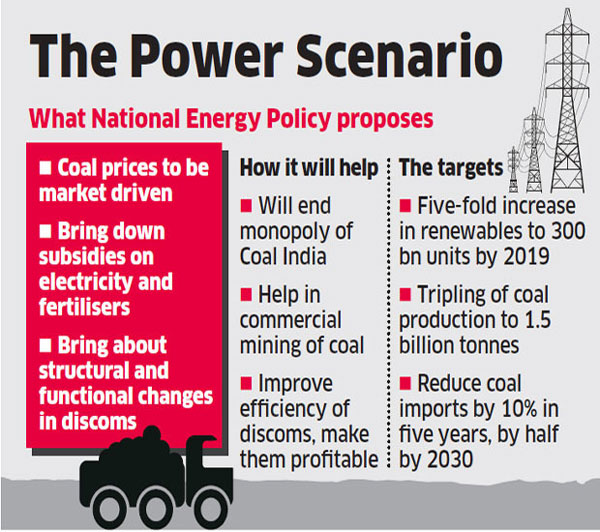UNIFIED MINISTRY FOR ENERGY
2020 MAR 15
Mains >
Polity > Executive > Ministries

IN NEWS:
In the Draft National Energy Policy (NEP), the NITI Aayog has advocated that a Unified Ministry of Energy be created by merging the various ministries.
PRESENT STRUCTURE:
- Four different ministries along with a multitude of regulators govern India’s energy sector.

- There are also different regulators for each type of fuel and energy source. E.g.: the petroleum and natural gas sector have two regulators – Directorate General of Hydrocarbons for upstream activities and the Petroleum and Natural Gas Regulatory Board for downstream activities.
- Along with this, there are State-level bodies that regulate electricity distribution companies, or DISCOMS.
ISSUES WITH CURRENT STRUCTURE:
- Fragmented approach towards attaining energy security: Multiple ministries and agencies are currently involved in managing energy-related issues, presenting challenges of coordination and optimal resource utilization. This is undermining the efforts to increase energy security.
- Constrains in data management: No single agency collects energy data in a wholesome and integrated manner. Data pertaining to consumption are barely available while supply side data collected by agencies of respective ministries are riddled with gaps.
- Complexity in energy management: Formulating an integrated and wholesome energy policy in the current governance structure is a complex and challenging task. This is due to lack of coordination among ministries, absence of quality consumption data and competition between them in the market, all of which may not always be the best option.
- Limited focus on Energy efficiency: On the energy efficiency front, the Bureau of Energy Efficiency is the sole statutory authority with the mandate to regulate energy efficiency on the consumption side. There is no agency or body for the same purpose on the supply side.
- Regulatory cholesterol: In the Indian energy sector, there are a number of energy laws, policies governing specific sector, state and local level energy regulations, administrative regulations and energy standards. Multiplicity of functional agencies with ambiguous objectives has hampered the growth of the sector and led to confusion among stakeholders.
SUGGESTIONS IN THE DRAFT ENERGY POLICY:
- NITI Aayog has advocated for a Unified Ministry of Energy to be created by merging Ministry of Petroleum and Natural Gas, Ministry of Coal, Ministry of New and Renewable Energy and Ministry of Power.
- The Department of Atomic Energy has been left out as an Independent Agency because of its strategic nature and involves issues of national security.
- The proposed ministry will have six agencies under it to handle various aspects of Energy Security:
1.Energy Regulatory Agency
2.Energy Data Agency
3.Energy Efficiency Agency
4.Energy Planning and Technical Agency
5.Energy Schemes Implementation Agency
6.Energy R&D agency
ADVANTAGES OF A UNIFIED MINISTRY:
- Integrated approach to energy security: A unified ministry would help India to have an integrated outlook on energy that would enable the optimal use of resources to meet the goals of energy security, sustainability and accessibility.
- Quicker policy response: Having a single energy ministry would allow the formulation and implementation of holistic energy management policies. It will ensure in better policy response, thereby enhancing India’s energy security.
- Improved energy efficiency: A single ministry can ensure better focus on both supply side and demand side of energy sector, thereby enhancing energy efficiency in the country.
- Holistic data collection and management: A single ministry will be in a better position to collect data regarding the generation, transmission and use of energy in the country. This can help in better prediction of future demands and formulation of sustainable policies.
- Improved energy access: A single ministry can provide a level playing field for various fuels, thereby help mop up the loss-making sectors. Also, synergy in administration can help address the issue of non-payment of dues by DISCOMs.
- Promising global experiences: Developed and efficient countries such as USA, UK, France and Germany have their diverse energy sectors administered by single ministry or department. There are also instances where the energy ministry is an conjunction with other portfolios such as environment, climate change, mines and industry.
|
MINISTRY OF JAL SHAKTI:
India has already shown a disposition towards unifying critical ministries. The Ministry of Jal Shakti was thus created, by integrating Ministry of Water Resources, River Development and Ganga Rejuvenation and Ministry of Drinking Water and Sanitation. The objective of this action is to unify water management functions, treat the issues of water management holistically and ensure better coordination of efforts. This was a crucial decision at a time when nearly 600 million Indians faced “high to extreme water stress”, while 75% households did not have drinking water on their premises.
|
WAY FORWARD:
- There are several independent bodies which work individually for the energy sector but do not have the national level development in focus. However, the development of the sector requires all these agencies to work in tandem to fulfil the objectives of safe, clean and sustainable energy for all. Hence a single body at the center like a single ministry is highly desirable in India.
- A unified Ministry of Energy will not only enable India to keep up with the global energy transition but also to continue to be a leader in adopting cleaner energy sources. However, a unified ministry is not a panacea to the issues ailing India’s energy sector.
- For this, there should be concrete efforts to address matters such as red tapism, twin balance sheet problem, reducing transmission losses, eliminating power theft, restructuring tariffs & cross subsidization and reducing fuel imports.
PRACTICE QUESTION:
Q. The draft National Energy Policy calls for a unified ministry for India’s energy sector. How far can they address the issues faced by the energy sector. Discuss?
